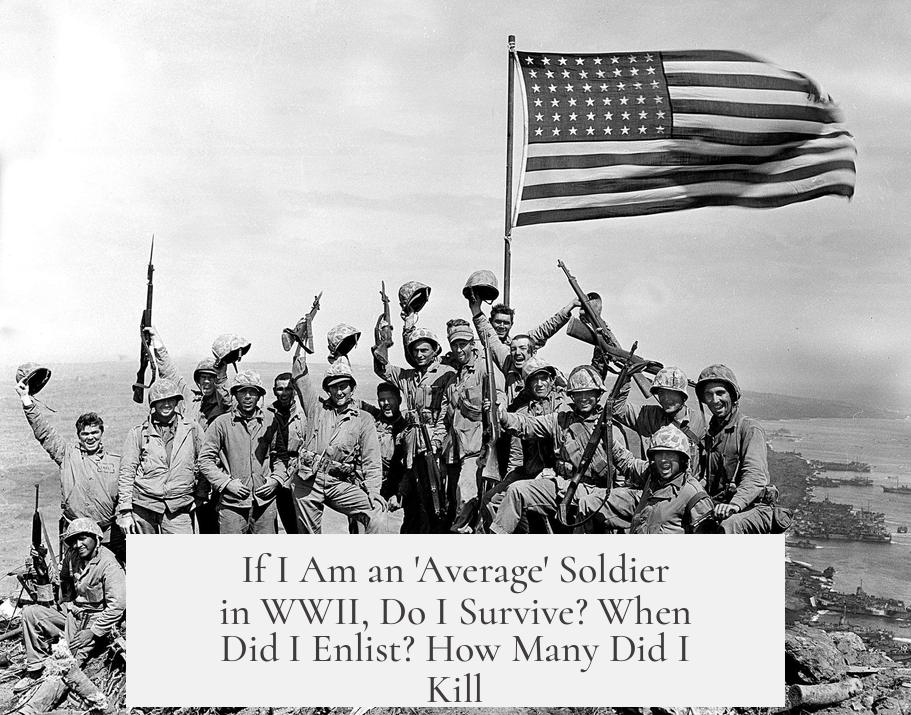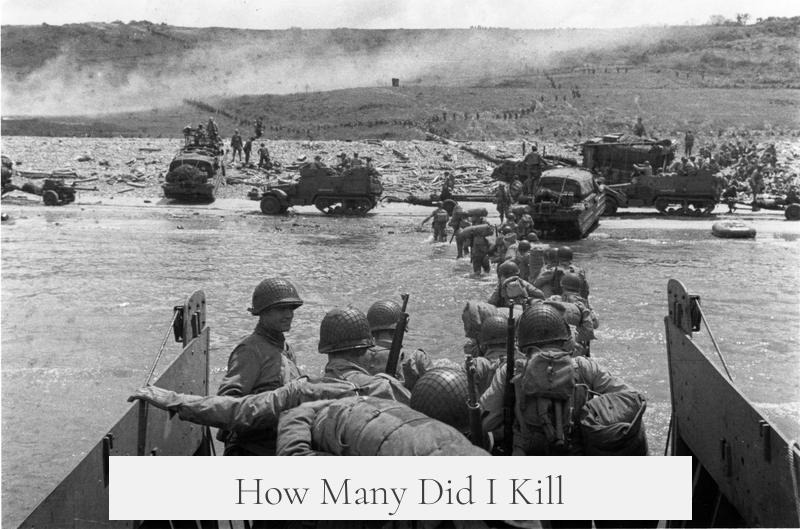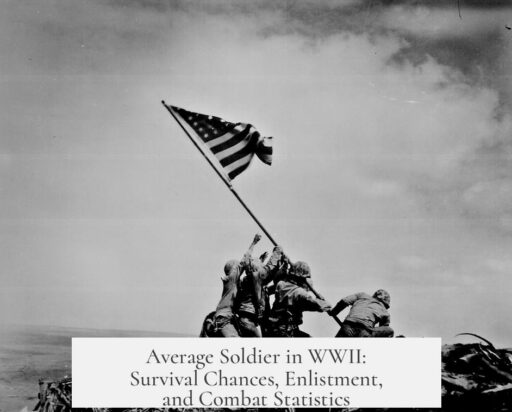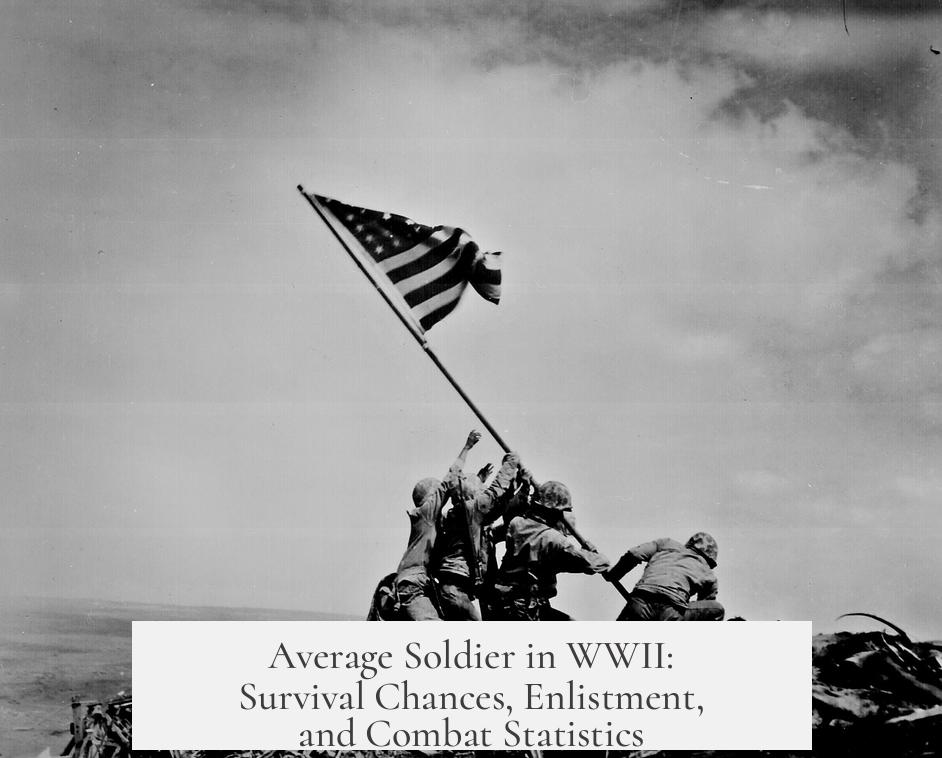If an average US soldier served in World War II, the odds favored survival. Statistically, the chance of surviving the war was roughly 35 to 40 to 1. This estimate comes from about 230,000 deaths out of 8 million in the army, or 416,000 deaths out of 16 million Americans who served overall. The US Army’s casualty rate was about 6%, one of the lowest among major combatants.
The army included a wide range of roles. Two support personnel existed for every combat soldier. This ratio meant only about one-third of soldiers saw combat. Some estimates suggest just 10% of soldiers actually engaged in battle. Many soldiers never fired their weapons in combat. High-casualty battles like Tarawa, Iwo Jima, and Okinawa saw heavy losses, but average soldiers more often served in less lethal areas.
Enlistment patterns show approximately 10 million men were drafted in World War II. The chance of being drafted was about 1 in 5. Soldiers enlisted or were drafted at various points, but many likely joined between 1940 and 1943, when US involvement was highest.
Determining how many enemies an average soldier killed is difficult. Records rarely specify individual kill counts. Given that many soldiers never fired their weapons in combat, the average number of kills per soldier is likely very low. Combat roles like infantry or paratroopers faced greater combat risk and may have higher kill estimates, but this varies widely.
| Category | Statistic |
|---|---|
| US Army Deaths | ~230,000 out of 8 million |
| Total Served (US) | ~16 million |
| US Army Casualty Rate | ~6% |
| Drafted Men | 10 million (chances ~5:1) |
| Combat Exposure | Approx 10-33% |
| Average Kills per Soldier | Unknown, likely low |
Several factors influenced survival odds and combat exposure. Branch of service, theater (Pacific vs. Europe), and specific battles had different risks. Paratroopers and front-line infantry faced much higher dangers. Additionally, injuries ranged widely, from minor wounds to severe disabilities. Prisoners of war also affected survival statistics.
- Chance of surviving the war was about 35 to 40 to 1 for an average soldier.
- Approximately 10 million men were drafted; draft chance was 1 in 5.
- Only about 10-33% of soldiers saw combat.
- Most soldiers never fired their weapon in battle.
- Average kills per soldier are unknown and probably low.
If I Am an ‘Average’ Soldier in WWII, Do I Survive? When Did I Enlist? How Many Did I Kill?

Imagine stepping into the shoes of an average U.S. soldier in World War II. You’re not a hero movie star, just a regular Joe drafted—or perhaps volunteering—to serve. The big questions loom: Will I survive? When do I join? How much combat do I see? And that haunting one—how many enemies do I kill?
Let’s break down these mysteries with cold, statistical facts and some straightforward analysis.
Do I Survive?
The short answer: Yes, most likely. The numbers speak loudly. Among approximately 8 million soldiers in the U.S. Army during WWII, about 230,000 died. That’s roughly a 35:1 chance of survival.
Looking at the total U.S. military involvement—16 million served, with 416,000 killed in action (KIA), 683,000 wounded (WIA), and 130,000 prisoners of war (POWs)—your chance of survival actually bumps up to around 40:1. In other words, for every fatality, there were about 40 who lived through it.
“The U.S. military was one of the safest to serve in during WWII, with a casualty rate hovering about 6%.”
Okay, survival sounds good on paper, but these numbers gloss over some important reality checks. For instance, wounds ranged wildly—from minor injuries that sent soldiers back into action to crippling wounds ending combat time. Also, some POWs captured during the war sadly died in captivity, which might inflate casualty numbers.
And don’t forget war’s swings. Your odds depend heavily on where you served. If you fought in the Pacific campaigns like Tarawa, Iwo Jima, or Okinawa, expect a higher battlefield death ratio. Paratroopers in the 101st or 82nd Airborne had dangerous missions behind enemy lines. Serving in a support role? Probably much safer.
When Do I Enlist or Get Drafted?
The U.S. draft was active during WWII. Approximately 10 million men were drafted, making your chances of being called up about 5:1.
If you’re the “average soldier,” chances are high you did not volunteer but were drafted. That means you received a knock on your door, a notice, and off you went. You’d enlist sometime between 1940 and 1945, depending on your age and needs of the military.
How Much Combat Do I See?
Here’s where the picture gets less clear—and more surprising.
- For every combat soldier, there were about two support personnel. So, nearly two-thirds of troops were not front-line fighters.
- Combat participation estimates vary, but as low as 10% of soldiers actually saw combat.
- Therefore, your chances as an average soldier of even firing your weapon in battle was low—approximately one-third or less.
Many soldiers never pulled the trigger on an enemy in their entire tour.
How Many Did I Kill?

As for the number of enemy kills, this is impossible to pin down for an “average” soldier.
Combat was chaotic, and kill records were often based on rough estimates or those taken by snipers or specialized troops. The average foot soldier? Likely responsible for zero confirmed kills.
So, if you were the typical infantryman, don’t fret about your war “scorecard.” Your contribution was more about presence, unit cohesion, and doing your assigned tasks.
What Does This All Mean for the ‘Average’ Soldier?
Your odds say you survive. The draft likely brought you into service, not your choice. Most combat soldiers never fired a shot, and many soldiers didn’t fight at all, serving in vital support roles. When you consider the hazards of fierce battles, being one of the 94% who avoided being killed or severely wounded is remarkable.
But risk varied by assignment—combat troops in the Pacific faced brutal odds. Airborne paratroopers were prime targets. And every role mattered—support troops kept the army running.
Why Does This Matter?
Understanding the “average” soldier’s experience cuts through glamorized war stories. It highlights how many lived ordinary lives in extraordinary times, far from glory, but crucial to the broader effort.
So next time you hear war stories, remember: many soldiers were drafted unexpectedly, survived tough odds, and many never even saw combat. Their contribution was essential, even if it doesn’t make dramatic headlines.
A Final Thought: What Would You Do?
Now, imagine yourself drafted today under those same statistics—would you be prepared to face the unknown? The chances of survival are stacked in your favor, but war is a wild card.
History shows us that being an average army man in WWII meant being part of a massive, complex machine. Whether firing a rifle or loading supplies, your role was a stitch in a vast tapestry shaping the world’s future.
| Aspect | Statistic | Implication |
|---|---|---|
| Survival Rate | ~35 to 40 times more likely to survive than die | Relatively safe compared to other armies |
| Draft Odds | About 5:1 | Most average soldiers were drafted, not volunteers |
| Combat Exposure | Only ~10-33% | Most soldiers saw limited or no combat |
| Kill Count | Indeterminate; often zero | Average soldier likely did not personally kill anyone |
In the end, war stats don’t tell the full story but help us understand the odds and realities faced by the typical soldier. Survival often hinged on where you served and your role. So next time you wonder, “If I served in WWII, what happened to me?”—now you know the nuanced answer.
Do I survive if I am an average US soldier in WWII?
Your chance of survival was about 35 to 1, based on the army’s death count. Overall, with 16 million serving and 416,000 killed, survival was roughly 40 to 1. The US Army had a low casualty rate of about 6%. But survival depended on your role and location.
Was I more likely drafted or enlisted?
About 10 million men were drafted. The chances of being drafted were around 5 to 1. Many soldiers joined through the draft rather than volunteering during WWII.
How many soldiers actually saw combat?
Only about 10 to 33% of soldiers saw combat. For every combat soldier, there were roughly two support personnel. Most soldiers never fired a weapon in battle.
How many people would an average soldier kill?
There is no reliable data on kills per average soldier. Many soldiers never engaged in direct combat or fired their weapons, making it impossible to estimate an average kill count.




